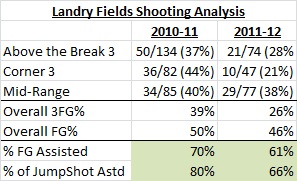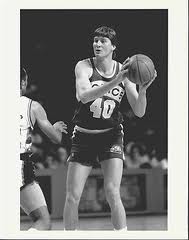The key to Landry Fields’ season could very well lie in his three point shooting ability.
As a rookie in 2010-11, Fields connected on 39% of his attempts from long range, putting him on the map as a potential floor-spacing weapon for the Knicks moving forward. In 2011-12, though, his three point efficiency tanked, falling to just 26%. Fields essentially went from being a sharpshooter to being someone who shouldn’t be allowed to shoot from outside.
While Fields does other things well on the floor, specifically rebounding and the “little things” that tend not to make the boxscore, most of his offensive value is derived from his shooting. So if Fields is a sharpshooter after all, the three year, $19M contract the Raptors gave him this offseason won’t seem too outlandish. But if he continues to be an offensive zero, it will look like quite the overpay for a contributing role player, likely one who will eventually come off the bench.
Playing with ‘Melo
So why did Fields’ three point efficiency drop off? A lot of the blame has been placed on the Knicks’ offense in 2011-12, specifically the impact of playing with ball stoppers Carmelo Anthony and Amare Stoudemire.
Late in the 2010-11 season, the Knicks acquired Anthony from the Nuggets and he played 27 games with them down the stretch. Fields’ three point shooting clips for the season had been 28.6%, 42.9%, 42.5% and 48.5% in November, December, January and February respectively. In March and April, those numbers fell to 38.9% and 25.0%.
So while Fields has played his entire career with Stoudemire, the anecdotal evidence that adding another ball stopper to the offense impeded Fields seems to be backed up by the first cursory glance at the split stats.
In fact, despite playing just 27 of 82 games together, Fields appeared with Anthony quite often, and five man units including both players were Fields’ fourth, fifth, seventh, ninth and tenth most common units. It seems playing with Ray Felton, Wilson Chandler and Danillo Gallinari agreed with his game more than playing with Chauncey Billups and Anthony.
It may actually have been the loss of Felton that had the bigger impact, as Felton’s assist rate generally hovers around 30%, compared to 25% in recent years for Billups and 20% for Toney Douglas, the other guard he played significant time with after the trade. If we look to last year, Jeremy Lin wasn’t quite a ball stopper but also had just a 27% assist rate, while Fields also spent significant time with Douglas, Iman Shumpert (19% assist rate) and Baron Davis (usually around 30% the past few years), none of whom would be confused with facilitating point guards.
Offensive Schemes
The narrative makes sense – offensive players who tend to have a lot of isolations run for them and who have low assist rates don’t foster strong ball movement. Ball movement not only involves everyone and spreads the touches around, but it also forces defensive rotations that can turn contested jump shots into poorly contested or uncontested ones. Picture a play where four players stand around the outside while a player dribbles in isolation – each defender can stay on their man with relative ease. But if the ball is being moved more, with screens or a pick-and-roll at the core of the set, every defender is moving his feet and can be forced to switch, putting a much greater focus on defensive awareness and communication, improving the chances for defensive breakdowns.
Now in Toronto, Fields finds himself playing with Kyle Lowry, who has roughly a 30% career baseline assist rate, and Jose Calderon, whose baseline generally sits above 40%. Fields is now playing in a more motion-oriented offense with point guards who are historically more focused on setting up teammates. Since 86% of Fields’ three point attempts were of the spot-up variety last year, it seems imperative that Fields be created for through the flow of the offense.
If we look at the comparison below, we see that Fields’ more successful season also saw him have a much larger share of his buckets come directly after a pass. The amount of assisted baskets he scored dropped from 70% to 61%, while the drop was even more significant for jump shots.

We can also see that Fields’ shooting fell across the board, but the drop was almost negligible on mid-range shots, providing hope that his jump shot may not be broken or flawed, but he just had three point opportunities that were of a poorer quality last year.
Looking Forward
We have already seen in just two preseason games that the presence of Jonas Valnciunas as a dive-man can cause trouble for a defense and require them to focus more attention in the paint. This can open up players at the elbow and in the corner, places that Calderon is very strong at finding teammates. If Kyle Lowry can replicate this ability to make passes out of the pick and roll, Fields should be afforded some better opportunities than he was last year. In addition, if Andrea Bargnani, a frequent target as a pop-man from the pick and pop, can identify situations where an extra pass can be of benefit, the offense should be able to get adequate touches for three outside shooters (I’m including Calderon or Lowry with Fields and Bargnani).
Of course, I didn’t see much Knicks tape from the past two years, no more than a normal non-Knicks fan basketball junkie would have, anyway. So it’s entirely possible that the fact that the numbers match up well with the narrative of Fields’ shooting woes is just a coincidence, and his shot is actually broken or his confidence shaken. It’s also possible that the usage demands of Bargnani, Lowry, and DeMar DeRozan could limit Fields’ touches, and he’ll be utilized more as a screener and rebounder than an offensive weapon. There is still much to be seen about the 2012-13 offense, considering we’re yet to see the starting point guard in action.
With that said, it doesn’t seem to be too much of a stretch to suggest that 2011-12 was an explicably poor outlier season for Fields as a shooter. He may have been over his head as a 30% marksman, but a more movement-oriented offense with players more willing to share the ball should help Fields return to be an effective spacing weapon.




